Kushan coinage



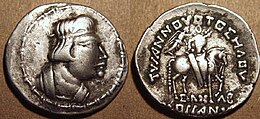
In the coinage of the North Indian and Central Asian Kushan Empire (approximately 30–375 CE) the main coins issued were gold, weighing 7.9 grams, and base metal issues of various weights between 12 g and 1.5 g. Little silver coinage was issued, but in later periods the gold used was debased with silver.[1]
The coin designs usually broadly follow the styles of the preceding
Much of what little information we have of Kushan political history derives from coins. The language of inscriptions is typically the Bactrian language, written in a script derived from Greek. Many coins show the tamga symbols (see table) as a kind of monogram for the ruler. There were several regional mints, and the evidence from coins suggests that much of the empire was semi-independent.
Kushan deities[4]

The Kushan religious
Representation of entities from Greek mythology and Hellenistic syncretism are:
- Ηλιος (Sarapis.
The Indic entities represented on coinage include:
- Βοδδο (boddo, Buddha)
- Μετραγο Βοδδο (metrago boddo, bodhisattava Maitreya)
- Mαασηνo (maaseno, Mahasena)
- Σκανδo koμαρo (skando komaro, SkandaKumara)
- þακαμανο Βοδδο (shakamano boddho, Shakyamuni Buddha)
The Iranian entities depicted on coinage include:
- Αρδοχþο (ardoxsho, Ashi Vanghuhi)
- Aþαειχþo (ashaeixsho, Asha Vahishta)
- Αθþο (athsho, Atar)
- Φαρρο (pharro, Khwarenah)
- Λροοασπο (lrooaspa, Drvaspa)
- Μαναοβαγο, (manaobago, Vohu Manah)
- Μαο (mao, Mah)
- Μιθρο, Μιιρο, Μιορο, Μιυρο (mithro and variants, Mithra)
- Μοζδοοανο (mozdooano, Mazda *vana "Mazda the victorious?")
- Νανα, Ναναια, Ναναϸαο (variations of pan-Asiatic nana, Sogdian nny, in a Zoroastrian context Aredvi Sura Anahita)
- Οαδο (oado Vata)
- Oαxþo (oaxsho, "Oxus")
- Ooρoμoζδο (ooromozdo, Ahura Mazda)
- Οραλαγνο (orlagno, Verethragna)
- Τιερο (tiero, Tir)
Additionally:
- Οηϸο (oesho), long considered to represent Indic Shiva,[5] but more recently identified as Avestan Vayu conflated with Shiva.[6][7]
- Two copper coins of Huvishka bear a 'Ganesa' legend, but instead of depicting the typical , but in the case of these two coins is generally assumed to represent Shiva.
Base metal issues
MacDowell (1968) identified three regional copper issues of
MacDowell (1960) proposed a gradual reduction of all three issues starting with Huvishka, while Chattopadhyay (1967) proposes a rapid devaluation of the issue by Kanishka. It seems that there were two reductions based on the coinage of the rulers just named.[8] Later issues were unified into a central coinage system of weights.
-
Bronze coin of Vima Takto. Corrupted Greek legend ΒΑΣΙΛΕΥ ΒΑΣΙΛΕΥΩΝ ΣΩΤΗΡ [ΓΗΕ.]: "The King of Kings, Saviour"
Gold coinage
Vima Kadphises issued three denominations of for this metal, a two of 15.75 grams, one of 7.8 grams and a quarter dinar piece of 1.95 grams.[9]
-
Gold dinar of Kushan king Kanishka II (200–220)
Imitations
The coinage of the Kushans was copied as far as the
References
- ^ "ONSNUMIS.ORG – Kshaharata Questions". 2021-08-03. Archived from the original on 3 August 2021. Retrieved 2022-02-26.
- ^ MacDowell, "Mithra"
- ^ MacDowell, "Mithra", 308–309
- ^ a b Cite error: The named reference
:0was invoked but never defined (see the help page). - ^ Sivaramamurti, pp. 56–59.
- ^ Sims-Williams, Nicolas. "Bactrian Language". Encyclopaedia Iranica. Vol. 3. London: Routledge & Kegan Paul.
- ^ H. Humbach, 1975, pp. 402–408. K.Tanabe, 1997, p.277, M.Carter, 1995, p.152. J.Cribb, 1997, p. 40. References cited in "De l'Indus à l'Oxus".
- ^ "The Devaluation of Huvishka's Coinage". kushan.org. Archived from the original on 2 March 2022. Retrieved 25 March 2007.
- ^ "COINS OF KUSHAN DYNASTY". Archived from the original on 8 September 2012. Retrieved 2022-02-26.
- ^ ISBN 9788120804401.
- ^ ISBN 9781438109961.
- ISBN 9780300119169.
- ^ Gupta inscriptions using the term "Dinara" for money: No 5–9, 62, 64 in Fleet, John Faithfull (1960). Inscriptions Of The Early Gupta Kings And Their Successors.
- ^ ISBN 9788120804401.
- ^ Pal, 78
- ISBN 9780520059917.
Further reading
- MacDowell, David W., "Mithra": "Mithra's Planetary Setting in the Coinage of the Great Kushans", in Études Mithriaques: Actes Du 2e Congrès International, Téhéran, Du 1er Au 8 Septembre, 1975, ed. Jacques Duchesne-Guillemin, 1978, BRILL, ISBN 9004039023, 9789004039025, preview
External links
- Online catalogue of Kushan coinage
- The Indo-Bactrian and Kushan coinage
- KANISHKA AND THE KUSHANA DYNASTY
- Kushan Empire
- ^ Singh, Arvind Kumar (1996). Coins of The Great Kushans (1st ed.). Parimal Publications.

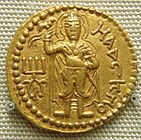


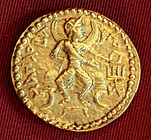
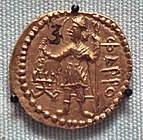
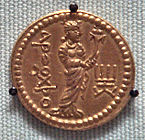
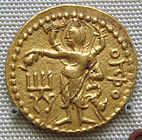



![Bronze coin of Vima Takto. Corrupted Greek legend ΒΑΣΙΛΕΥ ΒΑΣΙΛΕΥΩΝ ΣΩΤΗΡ [ΓΗΕ.]: "The King of Kings, Saviour"](http://upload.wikimedia.org/wikipedia/commons/thumb/1/1e/Coin_of_Kushan_King_Vima_Takto.jpg/120px-Coin_of_Kushan_King_Vima_Takto.jpg)


